Tips for Driving as an Amputee
Living with limb loss often brings changes to daily routines, but it doesn’t have to mean giving up independence. Amputation affects every aspect of your life in ways both expected and unexpected. Luckily, advancements in prosthetics and modifications have helped many amputees continue to participate in everyday activities they might have otherwise lost out on, including driving.
Read on to learn more about driving as an amputee and what you might need to get back behind the wheel.
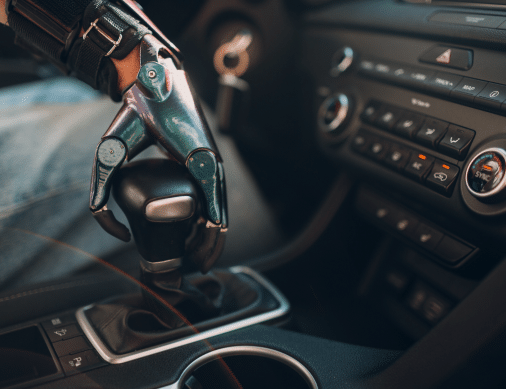
Can I Drive After I’ve Lost a Limb?
Yes! With proper modifications to your vehicle, amputation won’t stop you from continuing to drive to your heart’s content.
However, some states or municipalities might require you to obtain an enhancement on your driver’s license before you can legally hit the road after losing a limb. Check your local laws or reach out to a knowledgeable attorney for more information on any requirements you might face.
Can I Drive Commercially if I’m An Amputee?
You can also continue driving a commercial vehicle with a missing limb, including large trucks. However, you might need to take additional training and obtain enhancements to your commercial driver’s license. If you drive across state lines, you’ll need to complete a certification to demonstrate your ability to operate your vehicle with your prosthetics or modifications.
Driving a Manual Car As an Amputee
Driving with a manual transmission is a point of pride for some, and many sports cars enjoyed by hobbyists use a stick shift. While most sources recommend that amputees use an automatic transmission, you don’t need to give up using a manual transmission if you enjoy it. Some car modifications can make it easier to drive stick with a missing limb.
How to Drive with An Arm Amputation
Losing the use of an arm can hinder your ability to use a steering wheel and other dashboard controls properly, but there are several ways to use modified controls or prosthetics to drive.
If you’ve experienced a below-the-elbow, above-the-elbow, or forequarter amputation, you can add a steering knob or wheel spinner to allow you to steer more easily with your remaining hand. You can also modify your dashboard controls to make it easier to use turn signals, headlight settings, and windshield wipers.
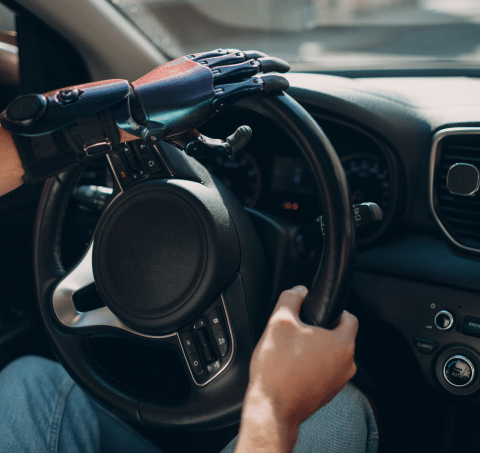
Hand Amputations
Those with partially amputated hands may be able to drive a car as normal, depending on the extent of the injury. If you can’t fully grip the wheel or have a full hand amputation or wrist disarticulation, you may need to install wheel or dashboard modifications. Using a prosthetic to steer can also be an option.
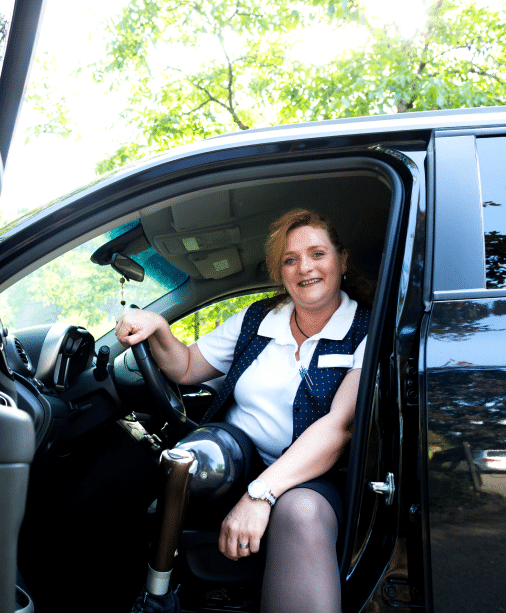
How to Drive with a Leg or Foot Amputation
Most amputations involving the left leg or foot may have less impact on driving, depending on your setup and needs, as most functions are controlled by the right foot. However, right leg or foot amputations present a range of options for adjusting your car’s controls.
You can attempt to drive using a prosthetic or by using your left foot to operate a traditional pedal setup. You can also have your accelerator pedal moved to the left side of the car, allowing for a more comfortable adjustment.
For those with above-the-knee amputations, including knee, hip, or pelvic disarticulations, installing hand controls may be easier and more comfortable than attempting to continue using floor pedals. The best option for one person might not work as well for others, so it’s important to consult your doctors to find the best choice for you.
How To Drive with a Bilateral Limb Loss
Navigating the challenges of driving with an amputation can be even more difficult without the benefit of an intact opposite limb. However, that doesn’t mean it’s impossible. Some vehicle modifications and configurations can help double amputees drive safely and effectively.

Double Upper-Extremity Amputation
Steering can still be intuitive and effective, depending on your prosthetic and vehicle setup. Body-powered hooks or a reduced-effort steering setup can help you operate a vehicle with a relatively traditional configuration.
Foot steering systems are also available, allowing you to control all steering functions and your vehicle’s dashboard just with your feet.
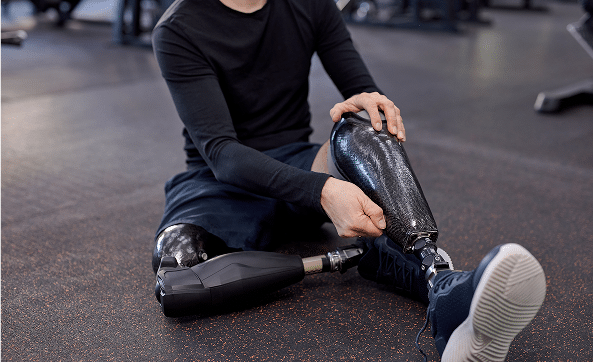
Double Lower-Extremity Amputation
While it’s possible for some with amputations affecting both legs to drive using a traditional setup with the right prosthetics, modifications are available that allow drivers to control all aspects of the vehicle with their hands, including levers for accelerating and braking.
Tips for Driving with Prosthetic Devices
In some situations, prosthetics can help amputees return to driving using a relatively standard setup. Some may prefer the normalcy of driving with prosthetics, even if it may create more physical difficulty or discomfort than using vehicle modifications.
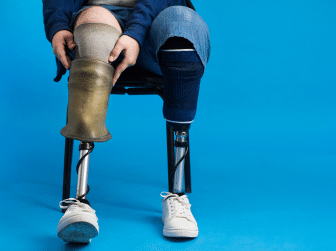
Tips for Driving with Double Prosthetic Devices
While difficult, some double amputees can operate a vehicle normally using prosthetics. Without vehicle modifications, this requires care and practice to ensure you can drive safely. Talk with your doctors to determine if you’re a good fit for driving with prosthetics.
Those with double leg or foot amputations may be able to use prosthetics to accelerate and decelerate using floor pedals. Some arm prosthetics, such as those that use body-powered hooks and wrist rotators, can allow double amputees to start an engine, steer, and perform other driving functions with minimal modifications.

Tips for Driving with an Upper Extremity Prosthetic
Vehicle modifications like steering knobs, wheel spinners, or dashboard controls may still be helpful to amputees who prefer to drive with upper-extremity prosthetics. While your prosthetics may allow you to grab a wheel, using a spinner knob will make it much easier to properly steer. Experiment with different options to determine what works best for you, and make sure to practice in a safe, distraction-free environment until you’re comfortable with your setup.
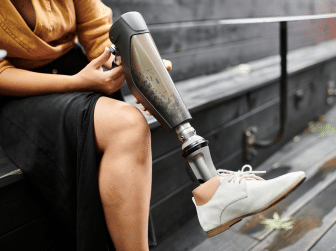
Tips for Driving with a Lower Extremity Prosthetic
With some effort, prosthetics can allow amputees to drive using a traditional pedal setup. It may take time to get a feel for how your prosthetic interacts with your environment and hone your perception of its location in relation to your remaining limb. Some prosthetic feet are designed to give sensory feedback that can be helpful when braking and accelerating.
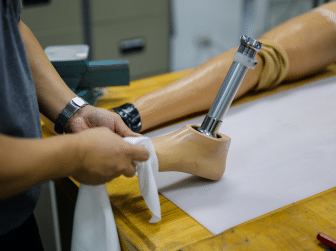
Transporting a Prosthetic Device
If you remove your prosthetic limb or limbs while driving, make sure to keep them secure in a case or other proper storage so they don’t get damaged while you’re underway.
Vehicle Modification
For many amputees, vehicle modifications are critical to driving unassisted. There are devices and configurations available to help those with nearly any type of amputation get back on the road safely and comfortably. Some organizations are also willing to provide financial assistance to help amputees purchase a modified vehicle or add features to their own.
What Vehicles Can Be Modified?
Most cars with automatic transmissions can be modified for disability controls. Some other vehicles like motorcycles and ATVs are also moddable.
What Vehicle Modifications Can Be Available?
Examples of adaptive driving equipment for amputees include:
- Steering knobs, which attach to the steering wheel and allow for easier turning
- Hand control setups that use levers to accelerate and brake instead of floor pedals
- Dashboard control mods that consolidate functions like turn signals and headlights into a keypad
- Left foot accelerators, which move the gas pedal closer to the left side for easier use
- Wheelchair lifts and transfer aids, which assist in entering and exiting the vehicle
- Gear shifts that use buttons to change modes
- Custom or modified seating and cushions
What Should I Look For in a Vehicle as an Amputee?
Some vehicles can include custom seating that can make it easier or more comfortable for you to drive with your amputation. Wheelchair accessibility can be an important feature for those with lower body amputations.
Make sure you’re able to comfortably get in and out of the vehicle. If not, you may need to consider further modifications or choosing a different car. Ensuring you have enough legroom—particularly if you have lower-extremity prosthetics—is key, as is having the ability to adjust your seating and steering wheel to a comfortable position.
If you’re getting financial assistance with purchasing a vehicle, make sure the car you’re looking at meets any specifications or budgetary requirements set by the organization helping you. Ask the dealer about any potential modifications the car might need and how it would incorporate them.
Vehicle Modification Resources
For more information on vehicle modifications and how to use them, visit one of the following resources.
Driving Should Be Safe and Accessible for Amputees
At Richmond Vona, we understand how important it is for injury victims to be able to access resources that can help them stay mobile and maintain a high standard of living. Co-founder Keith Vona and other attorneys with the firm are U.S. Military veterans who are committed to helping amputees—including disabled vets—get the justice and compensation they need.
If you need help finding or obtaining vehicle modifications or other resources, call us today at 716-500-5678. We pride ourselves on providing compassionate and aggressive advocacy for injury victims like you, and we care deeply about treating you with the dignity you deserve.
YOUR FUTURE IS WORTH FIGHTING FOR
"*" indicates required fields
